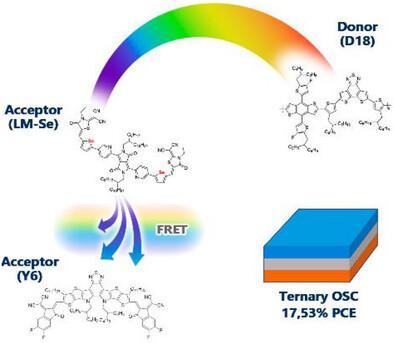利用吡啶侧链DPP受体调节三元有机太阳能电池中的激子动力学和能量传递
IF 26
1区 材料科学
Q1 CHEMISTRY, PHYSICAL
引用次数: 0
摘要
本研究报道了LM‐F、LM‐T和LM‐Se三种新型非富勒烯受体(nfa)的合成,它们具有双酮吡咯(DPP)核心,两侧是吡啶单元,并通过不同的π桥接杂环:呋喃、噻吩和硒烯连接到双氰基氨基末端。这些nfa具有A2-D-A1-D-A2的分子结构,并通过高效的方法合成。所有化合物都表现出良好的热稳定性,在可见光范围(550-800 nm)内具有广泛的吸收,并且适合有机太阳能电池(OSC)的应用。密度泛函理论(DFT)模拟揭示了激子解离的有利偶极矩,特别是在LM‐Se中。使用D18作为供体的二元OSCs的功率转换效率(pce)分别为10.23% (LM‐T)、12.25% (LM‐F)和13.84% (LM‐Se),其中LM‐Se的吸收范围更广,激子结合能更低,电荷输运增强。将LM‐Se加入到D18和Y6的三元共混物中((D18:LM‐Se:Y6 1:0.4:0.8), PCE进一步提高到17.53%,优于二元D18:Y6器件(15.12%)。这种增强归因于激子解离的改善、电荷传输的平衡、重组的减少和有效的Förster共振能量转移(FRET)。AFM和XRD分析证实了良好的形态和分子堆积,有助于减少能量损失和提高光伏性能。本文章由计算机程序翻译,如有差异,请以英文原文为准。

Tuning Exciton Dynamics and Energy Transfer in Ternary Organic Solar Cells Using Pyridine‐Flanked DPP Acceptors
This study reports the synthesis of three novel non‐fullerene acceptors (NFAs), LM‐F, LM‐T, and LM‐Se, featuring a diketopyrrolopyrrole (DPP) core flanked by pyridine units and connected to dicyanorhodanine terminals via different π‐bridging heterocycles: furan, thiophene, and selenophene. These NFAs exhibit an A2 –D–A1 –D–A2 molecular architecture and are synthesized through efficient methods. All compounds demonstrated good thermal stability, broad absorption in the visible range (550–800 nm), and suitable energy levels for organic solar cell (OSC) applications. Density functional theory (DFT) simulations revealed favorable dipole moments for exciton dissociation, especially in LM‐Se. Binary OSCs using D18 as donor achieved power conversion efficiencies (PCEs) of 10.23% (LM‐T), 12.25% (LM‐F), and 13.84% (LM‐Se), with LM‐Se showing superior performance due to broader absorption, lower exciton binding energy, and enhanced charge transport. Incorporating LM‐Se into a ternary blend with D18 and Y6 ((D18:LM‐Se:Y6 1:0.4:0.8) further improved the PCE to 17.53%, outperforming the binary D18:Y6 device (15.12%). This enhancement is attributed to improved exciton dissociation, balanced charge transport, reduced recombination, and efficient Förster resonance energy transfer (FRET). AFM and XRD analyses confirmed favorable morphology and molecular packing, contributing to reduced energy loss and enhanced photovoltaic performance.
求助全文
通过发布文献求助,成功后即可免费获取论文全文。
去求助
来源期刊

Advanced Energy Materials
CHEMISTRY, PHYSICAL-ENERGY & FUELS
CiteScore
41.90
自引率
4.00%
发文量
889
审稿时长
1.4 months
期刊介绍:
Established in 2011, Advanced Energy Materials is an international, interdisciplinary, English-language journal that focuses on materials used in energy harvesting, conversion, and storage. It is regarded as a top-quality journal alongside Advanced Materials, Advanced Functional Materials, and Small.
With a 2022 Impact Factor of 27.8, Advanced Energy Materials is considered a prime source for the best energy-related research. The journal covers a wide range of topics in energy-related research, including organic and inorganic photovoltaics, batteries and supercapacitors, fuel cells, hydrogen generation and storage, thermoelectrics, water splitting and photocatalysis, solar fuels and thermosolar power, magnetocalorics, and piezoelectronics.
The readership of Advanced Energy Materials includes materials scientists, chemists, physicists, and engineers in both academia and industry. The journal is indexed in various databases and collections, such as Advanced Technologies & Aerospace Database, FIZ Karlsruhe, INSPEC (IET), Science Citation Index Expanded, Technology Collection, and Web of Science, among others.
 求助内容:
求助内容: 应助结果提醒方式:
应助结果提醒方式:


